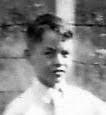Documenting the First World War it is richly embellished with gold decoration and gold edged pages and weighs nearly a stone. I have had it looked at by an antiquarian bookseller. He believes that “this beautifully bound book” was the work of a gifted amateur who probably intended it to be a contribution to the Arts & Craft movement which was active at that time (1920’s) At a fiver it was a steal and as much as I admire the fabric and content of the book I am quite sure that someone out there on Ebay will admire it even more than me. And if you are wondering why that strange object is in the photo - wonder no more - its a plug for my new book............
On the journey back we stopped to have a look at the church of St. Candida at Whitchurch Canonicorum. In the church we were met by Sue – a churchwarden – who shared with us some of the churches history. It is the only church in the country to have a shrine complete with bones, the bones of St. Wite to be exact. It seems that St. Wite may have been a hermit living on cliffs nearby who also may have been a beacon lighter (to warn of seaborne attack). She may have been killed by an invading army of Danes coming in at Charmouth but nobody is sure of the exact facts. Neither is anyone sure how the shrine escaped Henry VIII’s reformation blitz or Cromwells vandals but it did and Sue explained that the story goes that the villagers spirited it away and hid it until it was safe for it to return.
The top is a stone casket containing a lead coffin which holds the bones of a fortyish woman (they have been checked out). Underneath are three holes in which the pilgrims would place their poorly body parts praying at the same time for a cure. Many years ago there existed a leper colony nearby and in those days there were also holes on the outside wall so that these poor people who were forbidden from entering the church could also take advantage of the saints remains. Pilgrims were expected to leave a gift for the saint and risked life and limb from marauding robbers in their approach to the church through thickly wooded country. The churchwarden painted a vivid picture of what it must have been like for hundreds to have come here for “the cure” and as if to emphasise the point, and while standing with our backs to the altar, she pointed out the distinct downward slope of the stone floor to the door at the rear of the church. “It made it easier to sluice the blood and vomit outside” she explained. History always has had the ability to shock and I found this a powerful example.
Incidentally – and I only remembered it after we had left to resume our journey home - the Bulgarian dissident, Georgi Markov who was assassinated in the 70’s near Waterloo Bridge by having a ricin pellet fired into his leg from an umbrella gun, is buried in the churchyard.
Taking a roundabout route back to the caravan we stopped at one point on the route and watched a buzzard perched atop a carcass enjoying a delicious meal of “road kill” pheasant. I was barely ten feet away from him and as we stopped he paused, looked up and fixed us with a beady stare. Wife remarked that the expression on his face was quite clear “It’s mine and I’m not sharing!” Shame I did not have the camera ready.




















